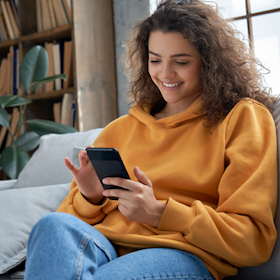 The Kyocera Echo was first introduced back in Feb and immediately grasped attention due to its unique dual-screen slider design. In honour of its impending release date on the 17th April we thought we’d give this Android 2.2 device a little mention.
The Kyocera Echo was first introduced back in Feb and immediately grasped attention due to its unique dual-screen slider design. In honour of its impending release date on the 17th April we thought we’d give this Android 2.2 device a little mention.
Mechanically, the Kyocera Echo operates just like any normal QWERTY slider or the Xperia Play, but instead of a keyboard or gamepad the user is gifted with another 3.5 inch capacitive touchscreen.
As with most new technological innovations these days the Kyocera Echo is being met with a fair amount of scorn. For some reason a lot of people can’t see how having two screens might be useful in a bunch of circumstances. Just because a device won’t necessarily meet your needs, doesn’t mean it won’t greatly appeal to others. We’re pretty big on supporting diversity and a variety of choice in the tech market so we thought we’d stand up and give the Echo its dues.
Disclaimer
Firstly it’s important to note that this phone is coming exclusively to the USA’s Sprint Network. That means that not only will it be unavailable to many Americans, but it will also simply not work in most of the rest of the world. The reason for this is that Sprint is one of the 2 top 4 US carriers that employ CDMA technology for their telecommunications. Most of the rest of the world uses GSM and unfortunately these two networks are vastly unsupportive of one another.
We’d also like to note that most of this post will be based around the positives and negatives of a dual-screen platform, rather than the pros and cons of the Kyocera Echo specifically.
The Pros
First the pros. You'll notice there's more of these than cons. We're not trying to push dual-screens as a new standard here, but when we thought about it there really were more reasons for hardcore phone users to have 2 screens rather than 1.
Here's what we came up with.
 Messaging
Messaging
If you’re like me you switch your phone to landscape whenever you want to type a message. It’s a great piece of innovation and has revolutionised the way I personally think about texting. Unfortunately for me and my fellow fat-fingered typists when you expand a software keyboard in to landscape mode there’s really very little other than the keypad that remains visible on the screen.
Yes, you could get a phone with a slider keypad, but adding that much girth to a phone just for the sake of easier messaging just doesn’t appeal to me as a user. Most of the time that physical keyboard would go unused, adding a mostly pointless degree of thickness to my phone.
However, giving me that functionality without making the compromise of an otherwise dead-weight keypad would be a fantastic solution for me. I’d still have most of the benefits of a slider keypad but when I wasn’t writing texts or emails I’d be able to use that whole extra surface for other uses.
 Emails
Emails
Other than the obvious link between emails and the previously mentioned issues with texting, there are still more ways dual-screens would assist emailing.
Sending multiple emails from a phone can certainly be an annoying experience, usually because of the lag time in between the inbox and loading a reply screen. Having 2 screens basically removes this problem from the picture entirely. You can start typing a reply on one screen while leaving your inbox open on the other. That way after you hit “send” and have to wait the 3-4 seconds for your phone to comply you can be already selecting the next email to reply to.
It doesn’t sound like much, but seconds definitely matter when you’re dealing with a repetitive task. A dual-screen setup for phone emails would basically be similar to Outlook in respect to the basic User Interface. We certainly wouldn’t have a problem with that.
You could also reply to an email without stopping whatever you were already doing. But we'll get to this kind of dual-functionality later.
 Web Surfing
Web Surfing
Dual-screen web surfing has been around for a long time in the desktop world. Many offices and homes now sport two monitors for their computers. It’s certainly a policy we support here at WhistleOut as we find it greatly increases productivity while simultaneously lowering the urge to introduce your keyboard to the nearest brick wall. It’s efficient, quick and basically awesome.
Even before dual-monitor setups you were able to make multiple windows in web-browsers so you could go between pages with relative ease. I personally remember cramming no less than 3 browsing windows and Microsoft Word all on to one 15 inch fishbowl CRT display back in high school and thinking it was the coolest thing ever. Now you’re telling me I can do it with a phone?
Having dual-screens for web browsing just makes things faster and more stress-free. Surfing the web is supposed to be an easy and enjoyable experience, not something you only do as a last resort when you need information. Although we sadly won’t be getting our hands on the Kyocera any time soon, this is still a major reason we hope for its success. Good sales for this model may mean a new range of dual-screen phones with global support in the future.
 Entertainment
Entertainment
With modern phones you generally have 1 option at a time when seeking to entertain yourself, unless you count surfing the web while listening to music as combining 2 fun diversions. With 2 screens running at once you could potentially have your happy cake and eat it too.
2 screens would allow you to combine movie watching, gaming, web-surfing, emailing, social media etc with each other 2 at a time. Got some friends you want to chat with on Facebook but desperately want to finish that TV show before you pull in to your stop? You could actually do both at once with dual screens. Even with phones starting to support multi-tasking they still feel a bit restrictive when it comes to entertainment. Adopting a dual-screen form-factor would be a good way of addressing this issue.
 Making Stuff Bigger
Making Stuff Bigger
This isn’t one we’d use too often, as 3.5 inches really is sufficient for most single functionalities of a phone. But if you want to get a bigger view of a map or web-page then you can expand your single image over two screens. This essentially creates one huge screen with a gap in the middle. It won’t replace a tablet but will definitely add an element of usability to your phone.
The Cons
We’ve raved about the pros of having dual-screens for a while now so it’s probably time to start talking about the draw-backs.
 Battery Life
Battery Life
Smartphones already tend to have issues with battery life these days without adding another screen to the mixture. We’re not sure how well the Kyocera Echo deals with another full-sized display as part of its hardware but we can assume that it would be a significant drain on power.
The screen is one of the most power-hungry elements of your phone, sitting up there with wireless internet and haptic feedback. Generally phones last from 5-7 hours when being intensively used. Adding another screen to that might significantly drop that figure to somewhere around 3-5.
You wouldn’t always be using the dual-screen. Most of what you do on a phone is easily handled with just the one, but for long car-trips or days where you spend a bunch of time on public transport you could find yourself running out of power pretty quickly.
 Thickness
Thickness
Slim is the new small. Remember back when phones just kept getting smaller and smaller? People used to joke about how the next generation would require a, electron microscope and a pair of micron tweezers just for interfacing. Well that all changed back when the iPhone came out in 2007.
Ever since screens have become important as both an interfacing tool and an entertainment conduit the focus has shifted from making the phone (and thus the display) smaller to making the device as thin as possible.
Slim phones definitely make a noticeable difference to your pocket, especially if you’re a tech junkie with multiple devices or a hipster with tight jeans. Adding an extra screen totally shoots this whole idea of comfort and class in the foot.
It basically comes down to which you would prefer. A thin phone or another screen? Once again this is totally up to the user; we just think the option should exist in the market. Like we said, we love variety.
Weight
This one is pretty simple. Screens are often one of the heaviest elements of a phone. More screen = more weight. If you think you can deal with that then there’s really no issue.
The WhistleOut Opinion
Whether or not a dual-screen phone is right for you is totally a matter of personal choice. We’re not telling you that dual-screens are better or worse than the traditional display forms, we just want to point out that there are a variety of circumstances in which they would be handy.
The Kyocera Echo has a great idea backing it and we really do hope it inspires competition in the market. More variety means more choice. Everyone uses their phone differently and there’s absolutely no reason we should all be held to the same set of rules.
What it all boils down to is that dual-screens would be really handy for some people and not so much for others. Variety is the spice of life and as our lives start embracing technology more and more there’s no reason we shouldn’t reflect our individuality through the gadgets we own. Dual-screens would be just one more form-factor in a shimmering sea of gadgets and gizmos and that kind of stuff makes us happy.
Related Articles
Find Better Phones and Plans
Hundreds of cell phone plans unpacked. All the facts. No surprises.

































